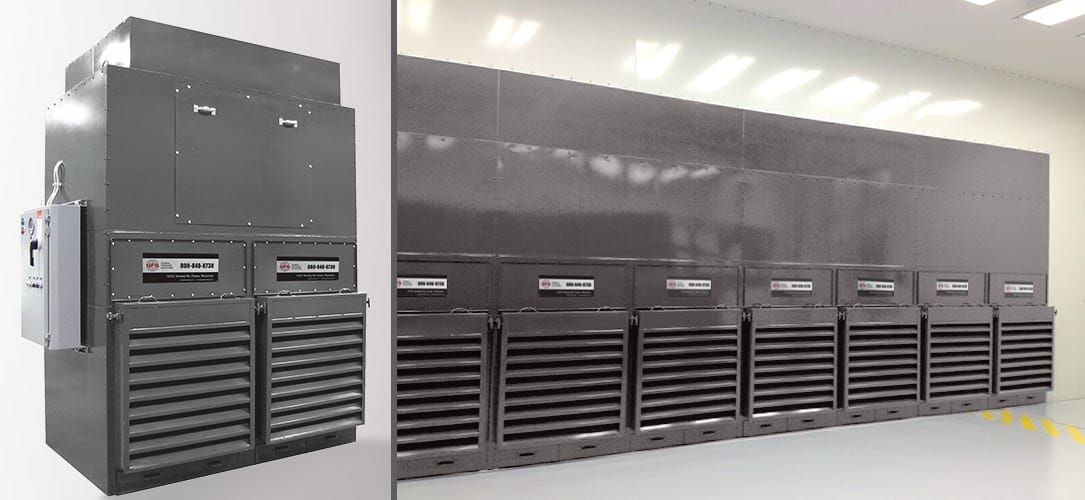
Workers at stone fabrication businesses who cut, grind and sand pieces of “engineered stone” to make kitchen and bathroom countertops may be inhaling dangerous amounts of silica dust that can lead to irreversible lung damage.
“Any dust is a problem for manufacturers and their employees, but the silica dust produced from engineered stone can be potentially deadly,” said Mark Freels, industrial territory manager for Global Finishing Solutions (GFS).
In addition to personal protective equipment (PPE), dust collection equipment can help employees working with engineered stone reduce the chance of contracting silicosis, a debilitating lung disease.
Silicosis is contracted by inhaling tiny particles of crystalline silica, which are released into the air during fabrication of engineered stone. Over time, a person’s lungs can become inflamed and develop scars. There is no treatment for silicosis other than a lung transplant.
Two people have died of silicosis and 16 others are inflicted with the disease as a result of working with engineered stone in California, Colorado, Texas and Washington, according to a 2019 report by the Centers for Disease Control and Prevention (CDC). A 2019 study found that at least 12 percent of Australian workers who cut stone countertops had silicosis.
With an estimated 96,000 workers employed at 8,700 stone fabrication businesses in the U.S., the fear is that a majority of American cases of silicosis in this industry are going unreported. There are no international codes for stone fabricators to follow; they must comply with safety regulations set forth by OSHA, although inspectors tend to focus more on large manufacturers. Small manufacturers tend to fly under the radar, and may not understand the dangers of silica dust or how to control it.
Silica is a crystal-like mineral found in sand, rock and quartz; it is commonly put in small packets — labeled “do not eat” — in new products such as shoes, handbags and electronics to absorb moisture. Engineered stone typically contains more than 90 percent silica. By comparison, granite usually contains less than 45 percent silica, and marble usually contains less than 10 percent silica.
The U.S. is importing eight times as much engineered stone today as it was 10 years ago. Engineered stone is often desired over natural stone since it is more affordable and less likely to crack or stain. To make engineered stone, bits of quartz are embedded in a resin binder, meaning its composition is almost entirely crystalline silica.

The safest way to cut engineered stone is to spray water on the cutting blades to keep silica dust from flying into the air. Still, dry-cutting methods are common practice, as they are generally cheaper because they do not require specialized equipment or water recycling systems.
Some stone fabricators require employees to wear a respirator when cutting engineered stone, but others provide only a face mask as PPE. Either way, inhaling at least small amounts of silica is often unavoidable, as the dust lingers in the air and eventually settles on equipment and the floor, and on workers themselves.
Having the proper dust collection equipment can help reduce the chance of workers contracting silicosis. Dust Collection Modules provide a safe, effective way for manufacturers to contain dust produced from sanding, grinding and blasting applications, such as stone fabrication. A Dust Collection Module from GFS can be integrated into a sanding, grinding or blast booth or can stand on its own in the part of a shop where dust is most prevalent.

Air is pulled into the module with the help of a direct-drive fan and motor, then passes through a high-efficiency cartridge filtration system featuring MERV 13-rated redundant filters. This allows the air to be cleaned — and rid of contaminants like silica dust — before it is exhausted back into the shop. The module essentially functions as a vacuum and an air purifier for manufacturers needing to contain dust.
“GFS has a product that can help,” Freels said. “The filtration system is the key component of the Dust Collection Module. It captures 90 percent of airborne contaminants, and when the air is returned to the shop, it is clean and safe to breathe.”
Although a Dust Collection Module from GFS will not completely protect someone cutting engineered stone from developing silicosis, it can prove valuable by controlling silica dust throughout the shop environment and helping stone fabrication workers stay safer on the job.
One of the best ways to highlight your business is through a story that you can share across your online platforms. It humanizes your business and shows that your business can make a meaningful impact. Your testimonial would be used as a project profile on the GFS Booth Blog and can be shared on your website and/or social media channels.
Complete this form and we’ll be in touch to showcase your company.

Shop a variety of GFS aftermarket products, including booth protection products and mobile accelerated curing units. And enjoy the convenience of fast and free ground shipping throughout the contiguous United States.

Located at GFS’ headquarters in Osseo, Wisconsin, the Center for Excellence is an innovative facility featuring an automotive refinish training center, as well as a separate space dedicated to technical product training.

GFS is continuously searching for talented, ambitious individuals to join our team. We aim to provide our employees with every opportunity to make an impact on the company and find their niche along the way — weather in a production, field services or an office position.